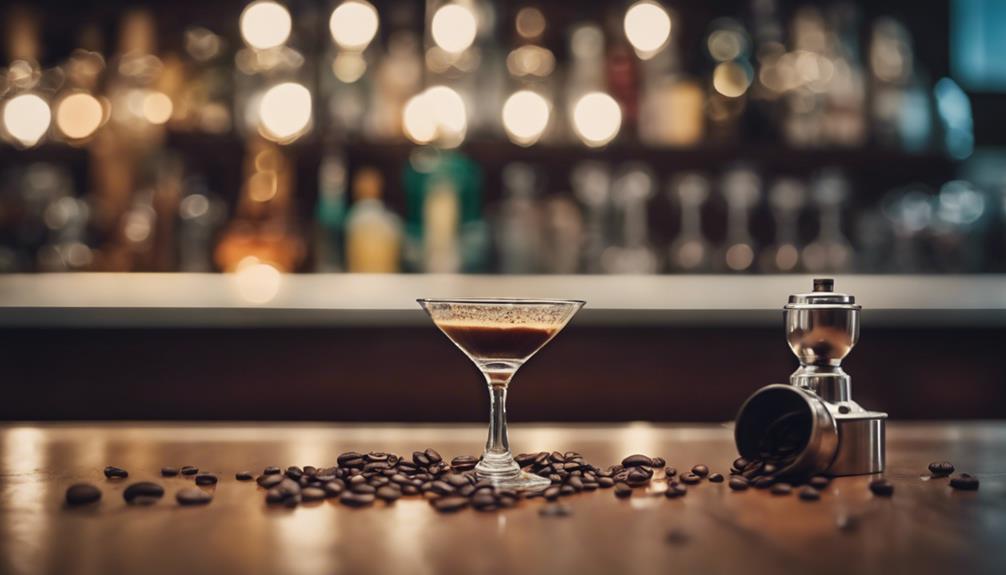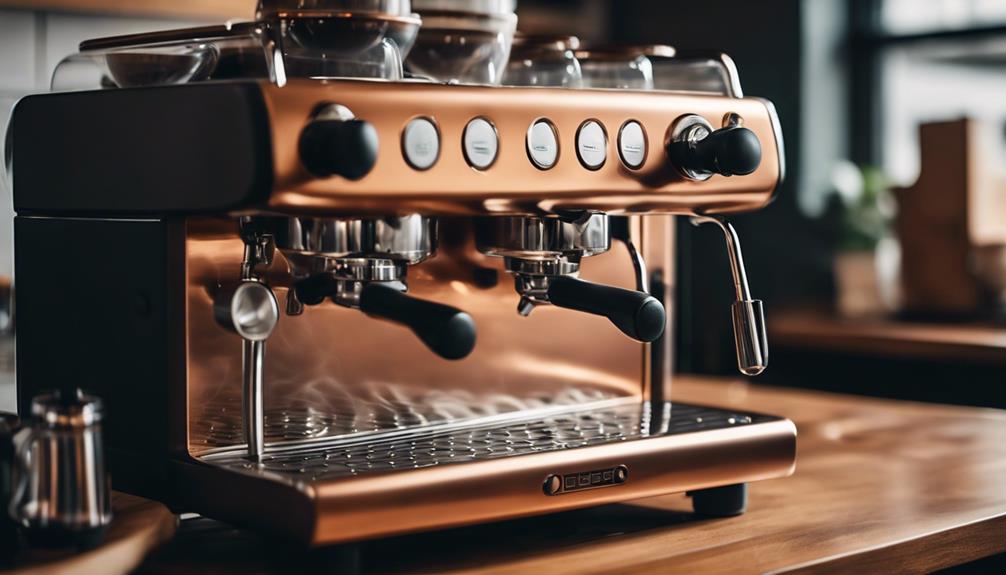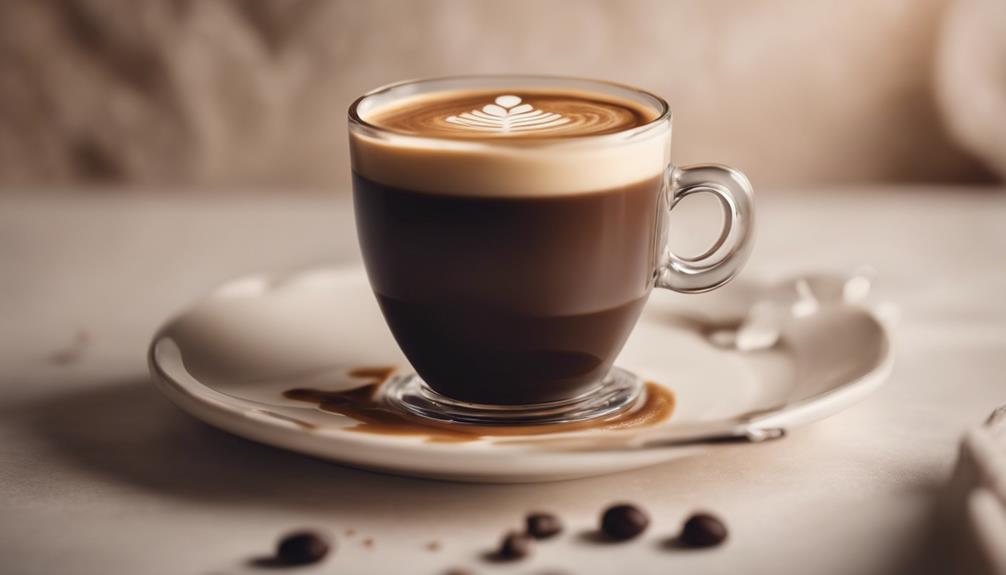Espresso shots do not technically ‘expire,’ but their flavor and quality degrade rapidly after extraction due to oxidation processes. Immediate consumption is crucial to enjoying the peak flavor. Storing in airtight containers helps maintain freshness, but factors like temperature and air circulation impact taste. Proper storage techniques, like refrigeration, can extend the lifespan of your espresso. Signs of expiration include loss of crema and increased bitterness. Maximizing flavor involves drinking promptly after brewing and savoring the crema layer. By understanding oxidation and following ideal storage practices, you can guarantee a more flavorful espresso experience.
Key Takeaways
- Espresso shots don't technically expire but rapidly lose peak flavor.
- Immediate consumption ensures best taste experience.
- Oxidation and degradation alter flavor quickly post-extraction.
- Proper storage in airtight containers delays flavor changes.
- Signs of expired espresso include loss of crema and increased bitterness.
Espresso Shot Shelf Life
Espresso shots lose their peak flavor within seconds of being pulled, making immediate consumption essential for the most enjoyable taste experience.
Once an espresso shot is extracted, oxidation and degradation processes kick in swiftly, altering its flavor profile. The rich crema that tops the espresso starts to dissipate, the color changes, and the flavors become more intense as time passes.
To savor the best taste of an espresso shot, it's advised to drink it within one minute of extraction.
Storing espresso shots in airtight containers can help maintain their freshness and flavor for a slightly extended period, but the best results are achieved through prompt consumption.
Remember, the essence of a perfect espresso shot lies in its immediate enjoyment after being pulled, capturing the delicate balance of flavors and aromas at their peak.
Factors Affecting Espresso Freshness
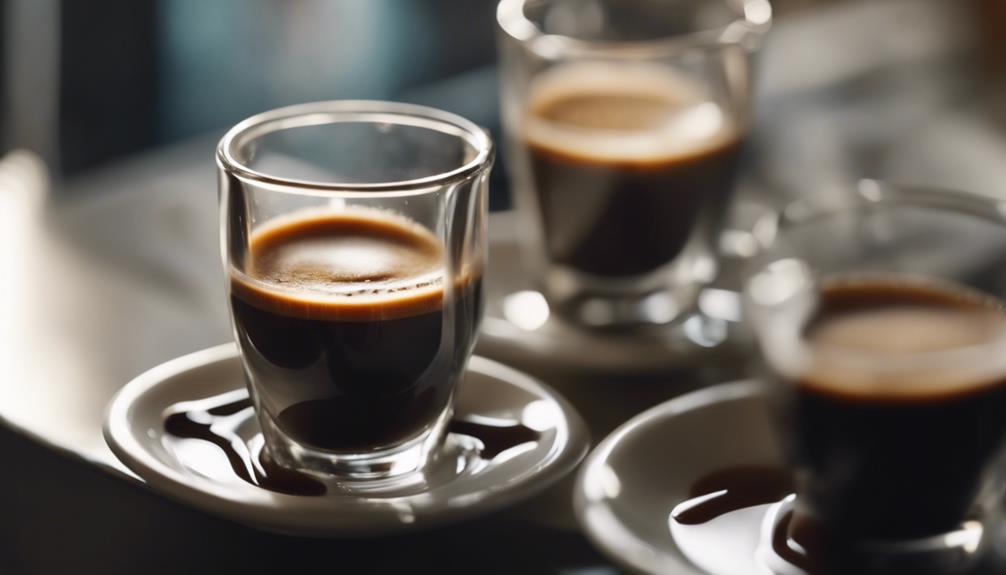
Storage conditions impact the freshness of your espresso. Factors like temperature, light exposure, and air circulation play an important role.
Additionally, the time between brewing and consuming your espresso can greatly influence its taste and quality.
Storage Conditions Impact
To maintain the freshness of your espresso shots, the importance of storage conditions plays a crucial role in preserving their flavor quality over time. Proper storage, such as using airtight containers or refrigeration, can greatly prolong the lifespan of your espresso. Exposure to air speeds up the oxidation process, leading to a decrease in flavor. Storing espresso in the fridge can keep it fresh for 4-5 days longer than leaving it at room temperature. When espresso loses freshness due to oxidation and air exposure, it can develop bitter, sour, or acidic notes. Following recommended storage practices and minimizing air contact are vital to ensure your espresso remains flavorful.
| Storage Method | Freshness Extension |
|---|---|
| Airtight Container | Prolonged freshness |
| Refrigeration | 4-5 days longer |
Brewing Time Influence
When brewing espresso shots, the timing greatly impacts their freshness and flavor profile. The shot of espresso reaches its peak within the first minute of brewing, making it the ideal window for consumption.
During this time, the crema on top of the espresso reintegrates with the liquid, enhancing the overall flavors and aroma. However, if the shot sits for as little as 10 seconds, you may notice a change in color, indicating oxidation and degradation that can affect the taste greatly.
To make sure you experience the full range of flavors in your espresso, it's vital to consume the shot promptly after brewing. Starbucks, a prominent coffee chain, emphasizes the importance of not letting espresso shots sit for too long to maintain the best flavor.
Impact of Oxidation on Espresso
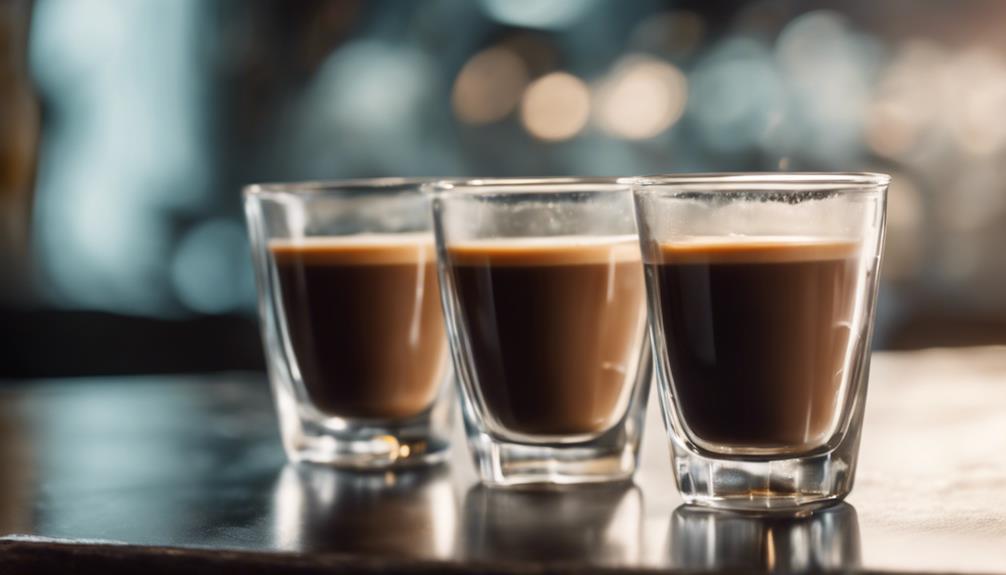
Oxidation plays a critical role in altering the flavor of espresso as it reacts with compounds in the coffee. Over time, this chemical process can lead to a noticeable change in taste, affecting the overall quality of the espresso shot.
To preserve the freshness of espresso and extend its shelf life, it's vital to understand how oxidation impacts the flavor profile and take appropriate measures to store and consume espresso promptly.
Oxidation and Espresso Flavor
Espresso flavor undergoes subtle changes as it interacts with oxygen, affecting the overall taste experience. Oxidation, a natural process, gradually alters the flavor profile of espresso over time. Initially, espresso can maintain its best flavor for a few minutes before oxidation starts to take its toll. Proper storage practices play an important role in delaying oxidation, thereby preserving the taste for a longer duration.
As espresso sits, oxidation leads to chemical reactions that transform its flavor, making it essential to understand this process to appreciate the ideal window for enjoying espresso shots. By comprehending the impact of oxidation on espresso flavor, you can gauge when the taste may start to deteriorate and make informed decisions on the freshness of your espresso.
Being mindful of oxidation and its effects can enhance your overall espresso drinking experience.
Shelf Life of Espresso
Understanding how oxidation impacts the shelf life of espresso is essential for maintaining its best flavor profile. When espresso is exposed to oxygen, the gradual oxidation process begins, altering its taste over time.
Here's how oxidation affects the shelf life of espresso:
- Flavor Changes: Oxidation leads to a breakdown of the coffee oils, causing the espresso to develop a more bitter taste as time passes.
- Short Timeframe: Properly stored espresso can retain its best flavor for a few minutes after extraction. Beyond this window, oxidation starts to compromise the taste.
- Natural Process: The oxidation of espresso is a natural chemical reaction that can't be completely prevented. However, delaying oxidation through suitable storage methods can help preserve the quality of the espresso and minimize the development of a bitter taste.
To maintain the best flavor in your espresso, it's vital to be mindful of oxidation and consume the coffee within a reasonable timeframe after extraction.
Preserving Espresso Freshness
To maintain the freshness of your espresso and preserve its flavor profile, proper storage techniques play an essential role in delaying the impact of oxidation. Oxidation gradually alters the taste of espresso over time, making it important to store it correctly to extend its shelf life. Espresso can maintain its flavor for a few minutes before oxidation notably changes its taste profile. Storing espresso in airtight containers helps mitigate oxidation, ensuring its flavors stay intact for a longer period.
To emphasize the importance of proper storage in preserving espresso freshness, consider the following table:
| Storage Method | Impact on Oxidation | Shelf Life Extension |
|---|---|---|
| Airtight containers | Lowers oxidation rate | Extends freshness |
| Exposure to air | Increases oxidation | Shortens shelf life |
| Cool, dark place | Slows oxidation | Preserves flavors |
| Room temperature | Accelerates oxidation | Reduces freshness |
Ideal Espresso Drinking Window

For an unparalleled espresso experience, timing is essential when it comes to savoring the perfect shot. To guarantee you enjoy your espresso at its peak, follow these guidelines:
- Consume Promptly: Espresso shots are best enjoyed within a minute of brewing. This timing allows you to experience the full range of flavors present in a freshly extracted shot.
- Short Drinking Window: The ideal time frame for savoring espresso is brief. Flavors can rapidly change and degrade post-brewing, with crema dissipating, acidity intensifying, and bitterness increasing as time progresses.
- Capture Peak Flavors: To appreciate the nuanced taste profile of espresso fully, it's vital to drink it promptly after brewing. Oxidation sets in quickly, affecting the flavor quality within minutes. By consuming your espresso promptly, you can relish its premium taste experience.
Storing Espresso Properly
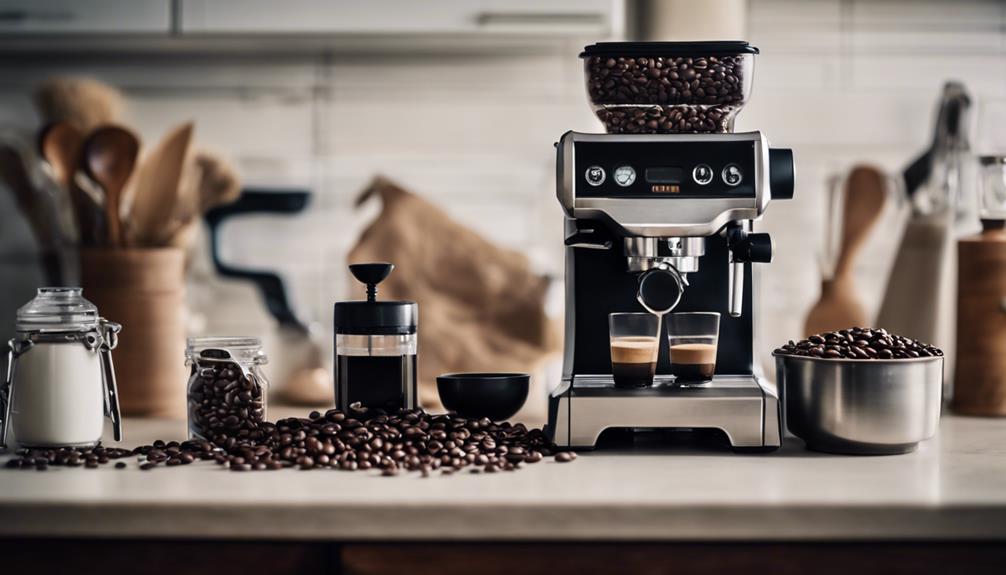
Properly storing espresso is crucial to maintaining its freshness and flavor profile over time. Storing your shot of espresso correctly can greatly impact its taste and quality. Here are some key points to keep in mind when storing espresso:
| Storing Method | Lifespan Extension |
|---|---|
| Airtight container | Preserves freshness |
| Fridge storage | Extends lifespan to 4-5 days |
| Ground beans storage | Fresh for 3-4 weeks |
To keep your espresso tasting its best, make sure it is stored in an airtight container to prevent exposure to air, which can lead to flavor deterioration. Placing brewed espresso in the fridge can prolong its lifespan, maintaining its taste for several days. Ground espresso beans can also stay fresh for weeks when stored properly. By following these storage tips, you can enjoy a flavorful and satisfying shot of espresso every time.
Signs of Expired Espresso
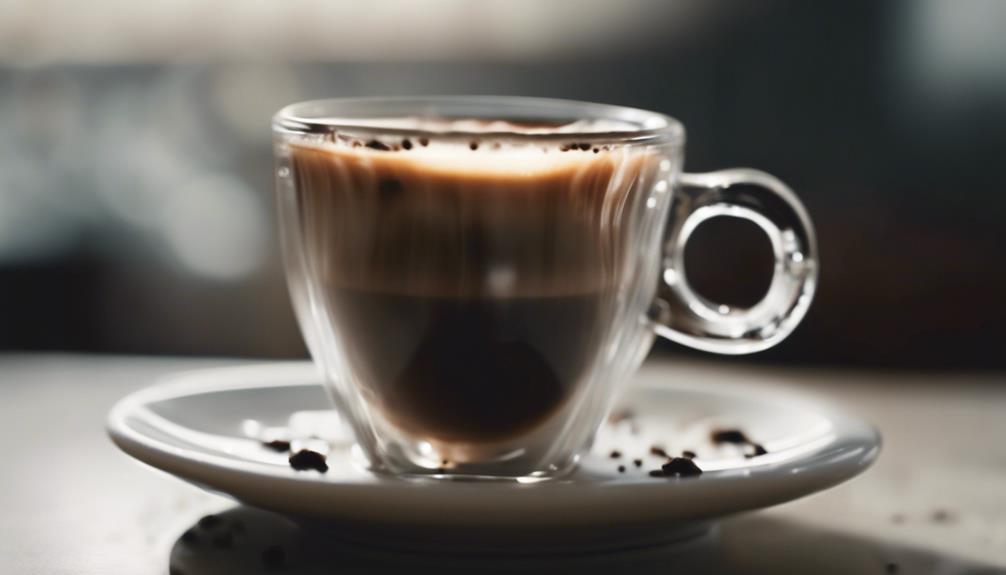
Expired espresso exhibits noticeable signs such as changes in color, loss of crema, increased bitterness, and acidity.
To help you identify when your espresso has expired, here are some key indicators:
- Loss of Crema: One of the most significant signs of expired espresso is the absence or rapid dissipation of the crema on top. Crema, the golden-brown foam layer on your espresso, indicates freshness. If the crema is thin or disappears quickly, it's a clear signal that your espresso may have expired.
- Increased Bitterness: Expired espresso tends to become overly bitter, losing its balanced flavor profile. If you notice a sharp increase in bitterness when tasting your espresso, it's likely past its prime.
- Acidity Changes: As espresso ages, the acidity levels can shift, resulting in a sour or unpleasant taste. If your espresso starts tasting overly acidic or sour, it's a sign that it has expired.
Extending Espresso Lifespan
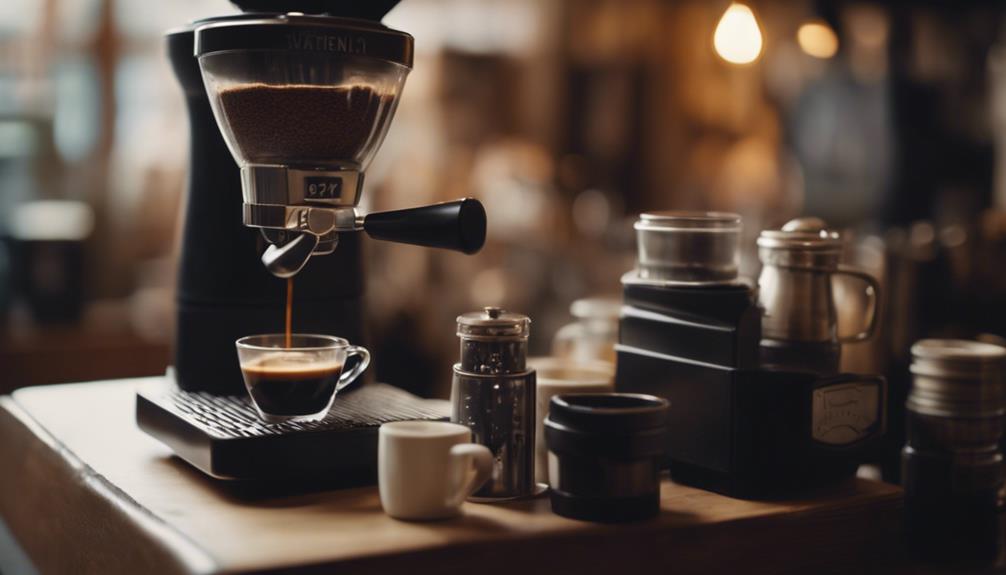
To prolong the lifespan of your espresso shots, consider utilizing airtight containers and refrigeration for best preservation. Storing espresso at room temperature exposes it to oxygen, leading to quicker oxidation and flavor deterioration.
By transferring your espresso shots to airtight containers immediately after brewing, you can limit their exposure to air and slow down the oxidation process. Placing these containers in the refrigerator further helps in maintaining the freshness of your espresso for a longer period.
While room temperature storage can be convenient, it accelerates flavor changes in espresso, affecting its taste profile sooner. By opting for refrigeration, you can extend the lifespan of your espresso shots and enjoy a more consistent flavor over several days.
Maximizing Espresso Flavor

Maximizing the flavor of your espresso shots involves savoring them promptly after brewing to experience their full richness. Here are three key points to keep in mind:
- Drink Quickly: It's challenging to taste the subtleties of a well-brewed espresso if you wait too long. The degradation process starts affecting the taste within seconds, making it difficult to fully appreciate the flavor profile.
- Enjoy the Crema: The crema, that delightful layer on top of your espresso shot, starts to integrate back into the liquid within the first minute. Consuming your shot promptly allows you to enjoy the enhanced flavor that the crema provides.
- Follow Recommendations: Starbucks suggests consuming espresso shots promptly to relish the best flavor before taste degradation occurs. For the best taste experience, aim to drink your espresso within one minute of being brewed to capture the full richness and complexity of the flavor.
Frequently Asked Questions
How Long Do Espresso Shots Last?
Espresso shots typically last for about 1 minute before the flavor noticeably changes. The color of the espresso also shifts after sitting for just 10 seconds.
Oxidation and degradation play a significant role in altering the taste of espresso shots over time. Starbucks advises consuming espresso promptly to avoid flavor deterioration.
For the best taste experience, it's recommended to drink espresso shots within one minute of brewing.
What Is the 10 Second Rule for Espresso?
The 10-second rule for espresso suggests savoring the shot within that time frame to fully enjoy its rich flavor profile. This technique allows you to experience the complex notes and aromas at their peak, enhancing your overall espresso experience.
By consuming your espresso promptly, you can appreciate the nuances and subtleties that make each shot unique.
What Is the Life Span of an Espresso Shot?
The lifespan of an espresso shot is fleeting, with peak flavor lasting around one minute. After this time, oxidation and degradation start to affect its taste.
To enjoy the highest quality, it's recommended to consume your shot promptly. Starbucks advises against letting espresso shots sit for too long due to these flavor changes.
Remember that stirring your espresso shot before drinking can enhance its taste profile by reintegrating the crema with the liquid.
Does Espresso Actually Expire?
Espresso, like many consumables, undergoes changes over time. While it doesn't 'expire' in the traditional sense, the flavor can indeed evolve.
Oxidation plays a key role in this transformation, affecting the taste profile. Proper storage can extend the enjoyment window, but rushing through a shot might mean missing out on subtle nuances.
Take your time to savor each sip – it's a journey of taste waiting to be appreciated fully.
Conclusion
In the end, remember that like a fine wine, espresso shots do have a shelf life. By understanding the factors affecting freshness, storing espresso properly, and being mindful of signs of expiration, you can enjoy your espresso at its peak flavor.
So, savor each shot within its ideal drinking window to experience the full richness and complexity of this beloved beverage. Cheers to perfectly brewed espresso!

